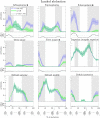Does enforcing glenohumeral joint stability matter? A new rapid muscle redundancy solver highlights the importance of non-superficial shoulder muscles
- PMID: 38033021
- PMCID: PMC10688910
- DOI: 10.1371/journal.pone.0295003
Does enforcing glenohumeral joint stability matter? A new rapid muscle redundancy solver highlights the importance of non-superficial shoulder muscles
Abstract
The complexity of the human shoulder girdle enables the large mobility of the upper extremity, but also introduces instability of the glenohumeral (GH) joint. Shoulder movements are generated by coordinating large superficial and deeper stabilizing muscles spanning numerous degrees-of-freedom. How shoulder muscles are coordinated to stabilize the movement of the GH joint remains widely unknown. Musculoskeletal simulations are powerful tools to gain insights into the actions of individual muscles and particularly of those that are difficult to measure. In this study, we analyze how enforcement of GH joint stability in a musculoskeletal model affects the estimates of individual muscle activity during shoulder movements. To estimate both muscle activity and GH stability from recorded shoulder movements, we developed a Rapid Muscle Redundancy (RMR) solver to include constraints on joint reaction forces (JRFs) from a musculoskeletal model. The RMR solver yields muscle activations and joint forces by minimizing the weighted sum of squared-activations, while matching experimental motion. We implemented three new features: first, computed muscle forces include active and passive fiber contributions; second, muscle activation rates are enforced to be physiological, and third, JRFs are efficiently formulated as linear functions of activations. Muscle activity from the RMR solver without GH stability was not different from the computed muscle control (CMC) algorithm and electromyography of superficial muscles. The efficiency of the solver enabled us to test over 3600 trials sampled within the uncertainty of the experimental movements to test the differences in muscle activity with and without GH joint stability enforced. We found that enforcing GH stability significantly increases the estimated activity of the rotator cuff muscles but not of most superficial muscles. Therefore, a comparison of shoulder model muscle activity to EMG measurements of superficial muscles alone is insufficient to validate the activity of rotator cuff muscles estimated from musculoskeletal models.
Copyright: © 2023 Belli et al. This is an open access article distributed under the terms of the Creative Commons Attribution License, which permits unrestricted use, distribution, and reproduction in any medium, provided the original author and source are credited.
Conflict of interest statement
The authors have declared that no competing interests exist.
Figures






References
-
- Lippitt S, Matsen F. Mechanisms of glenohumeral joint stability. Clinical orthopaedics and related research. 1993;(291):20–28. - PubMed
MeSH terms
LinkOut - more resources
Full Text Sources

